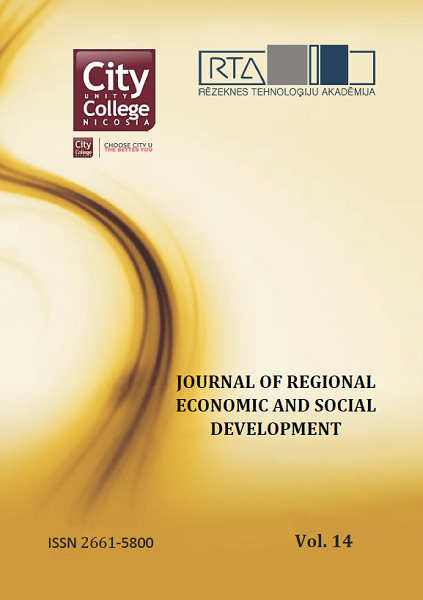THEORETICAL ASPECTS OF THE ROLE OF THE SHADOW ECONOMY
DOI:
https://doi.org/10.17770/jresd2022vol14.6978Keywords:
definitions of the shadow economy, economic theoriesAbstract
The shadow economy is definitely a significant problem throughout the world. Research studies on the shadow economy still lack a single approach to the term shadow economy. Several definitions of the shadow economy are used to assess the role of the shadow economy.
The present research aims to examine the theoretical role of the shadow economy and the definitions thereof given in various economic theories.
Analysing the definitions of the shadow economy, researchers identify ambiguous interpretations of the term given in various theories. The term shadow economy has a considerable number of synonyms used for researching the shadow economy. Some definitions focus on hidden outcomes, whereas others focus on hidden employment. A definition of the shadow economy is of great importance in assessing the size of the shadow economy.
The research employed the following methods: monographic, descriptive, as well as analysis, synthesis and document analysis.
References
Alderslade, J., Talmadge, J., & Freeman, Y. (2006). Measuring the informal economy: One neighborhood at a time. Washington, DC: Brookings Institution, Metropolitan Policy Program
Bank of Latvia (29 November 2021). Notiks diskusija par ēnu ekonomikas un aplokšņu algu ierobežošanas iespējām (Discussion to be held about the shadow economy and the possibilities of limiting envelope wages). Available at: https://www.bank.lv/lb-publikacijas/zinas-un-raksti/latvijas-bankas-informacija-presei/12668-notiks-diskusija-par-enu-ekonomikas-un-aploksnu-algu-ierobezosanas-iespejam (accessed: 15/01/2022)
Bank of Latvia (s.a.). Ēnu ekonomika (Shadow Economy). Available at: https://www.naudasskola.lv/lv/mana-ekonomika/limeni/10-12/labklajiba/enu-ekonomika (accessed: 19/12/2021)
Brekis, E. (2007). Latvijas ēnu ekonomikas modelēšana: nodokļu politikas aspektā (Modelling the Shadow Economy of Latvia: the Aspect of Tax Policy). Available at: https://dspace.lu.lv/dspace/bitstream/handle/7/5152/25616-Brekis_Edgars_Dokt020104.pdf?sequence=1 (accessed: 09/01/2022)
Chen, M. A. (2012). The Informal Economy: Definitions, Theories and Policies. WIEGO working Paper No.1, p.26
De Soto H. (2000): The Mystery of Capital: Why Capitalism Triumphs in the West and Fails Everywhere Else, Basic Books, p.275
Doeringer, P.B., & Piore, M.J. (1971). Internal Labor Markets and Manpower Analysis (1st ed.). Routledge, https://doi.org/10.4324/9781003069720
Gerxhani, K. (2004). The informal sector in developed and less developed countries: A literature survey. Public choice, 120(3), pp.267-300
Godfrey, P. C. (2011). Toward a theory of the informal economy. Academy of Management Annals, 5(1), pp.231-277
Hassan, M., & Schneider, F. (2016). Size and development of the shadow economies of 157 worldwide countries: Updated and new measures from 1999 to 2013. Journal of Global Economics, 4(3), pp.1-15
Hussmanns, R. (2004). Measuring the informal economy: From employment in the informal sector to informal employment (Vol.53, p.32). Policy Integration Department, Bureau of Statistics, International Labour Office
Kazimieraityte, M., & Skvarciany, V. (2019). Šešėlinę ekonomiką lemiančių veiksnių tyrimas. Mokslas-Lietuvos ateitis, 11(1). Available at: https://journals.vilniustech.lt/index.php/MLA/article/view/9388/8936 (accessed: 23/04/2022)
Kelmanson, M. B., Kirabaeva, K., Medina, L., Mircheva, M., & Weiss, J. (2019). Explaining the Shadow Economy in Europe: Size, Causes and Policy Options. International Monetary Fund, WP/19/278. Available at: https://www.imf.org/~/media/Files/Publications/WP/2019/wpiea2019278-print-pdf (accessed: 21/04/2022)
Khadiullina, G., Shurkina, E., & Svirina, A. (2013). Informal Economy Dynamics as an Important Factor Defining Level of Social Unease. Journal of Economics Studies and Research, 2013, pp.1-13, https://doi.org/10.5171/2013.720741
Koufopoulou, P., Williams, C. C., Vozikis, A., & Souliotis, K. (2019). Shadow Economy: Definitions, terms & theoretical considerations. Advances in Management and Applied Economics, 9(5), pp.35-57. Available at: https://www.researchgate.net/profile/Paraskevi-Koufopoulou/publication/333080662_Shadow_Economy_Definitions_terms_theoretical_considerations/links/5cdf91f192851c4eabaa5528/Shadow-Economy-Definitions-terms-theoretical-considerations.pdf (accessed: 09/01/2022)
Maiti, D., & Sen, K. (2010). The informal sector in India: a means of exploitation or accumulation?. Journal of South Asian Development, 5(1), pp.1-13
Maloney, W. F. (2004). Informality revisited. World development, 32(7), pp.1159-1178
Ministry of Finance (9 February 2021). Ēnu ekonomika (Shadow Economy). Available at: https://www.fm.gov.lv/lv/enu-ekonomika (accessed: 01/01/2022)
Perry, G. (Ed.). (2007). Informality: Exit and exclusion. World Bank Publications
Saint-Paul, G. (1996). Dual labor markets: a macroeconomic perspective. MIT press
Sanyal, K. (2007). Rethinking capitalist development: Primitive accumulation, governmentality and post-colonial capitalism. Routledge, New Delhi, India
Sanyal, K., & Bhattacharyya, R. (2009). Beyond the factory: globalisation, informalisation of production and the new locations of labour. Economic and Political Weekly, pp.35-44
Sauka, A., Schneider, F., & Williams C. C. (2016). Entrepreneurship and the Shadow Economy. Edward Elgar Publishing. Available at: https://www.elgaronline.com/view/edcoll/9781784719876/9781784719876.xml (accessed: 12/04/2022)
Schneider, F. (2014). Outside the State – the Shadow Economy and Shadow Economy Labor Force. CESifo Working Paper No. 4829, Category 1: Public Finance. Available at: https://www.econstor.eu/bitstream/10419/102178/1/cesifo_wp4829.pdf (accessed: 12/04/2022)
Schneider, F., & Enste, D. (2000). Shadow Economies Around the World: Size, Causes and Consequences. Causes and Consequences. Available at: https://www.elibrary.imf.org/view/journals/001/2000/026/article-A001-en.xml (accessed: 01/01/2022)
“Swedbank” AS (16 March 2020). Mūsdienīgi norēķini – klientu paradumi un tirgotāju risinājumi (Modern Payments – Customer Habits and Merchant Solutions). Available at: https://biznesam.swedbank.lv/ievads/finanses/beskaidras-naudas-norekini-52973, (accessed: 08/05/2022)
Tanzi, V. (2002). The shadow economy, its causes and its consequences. Edited Lecture. Brazilian Institute of Ethics. Available at: http://citeseerx.ist.psu.edu/viewdoc/download;jsessionid=083EAE89C39A8A837C5033F17A30EBDA?doi=10.1.1.581.4386&rep=rep1&type=pdf (accessed: 12/04/2022)
VanderBerg, N. (2014). The informal economy: A literature review. Unpublished paper. Retrieved from http://www. westnh. org/wpcontent/uploads/2014/06/PHASE-1-_-Appendix-B_Informal_Economy_Literature-Review. pdf
Wallerstein, I. (2004). World-systems analysis. In World-Systems Analysis. Duke University Press, p.128


